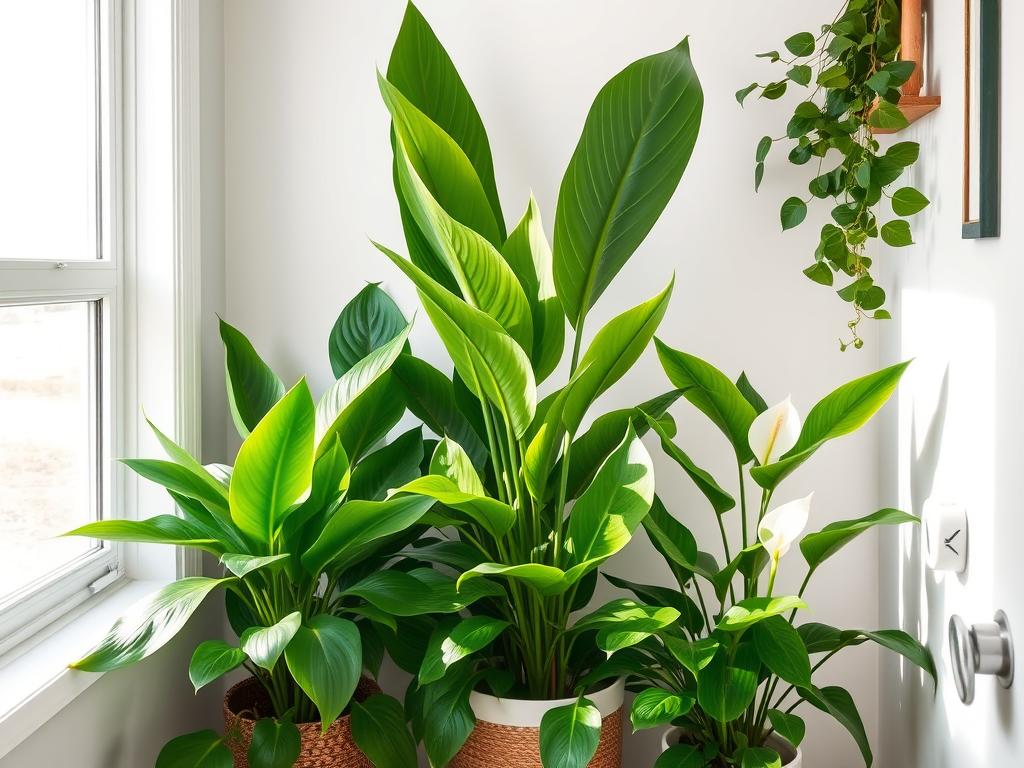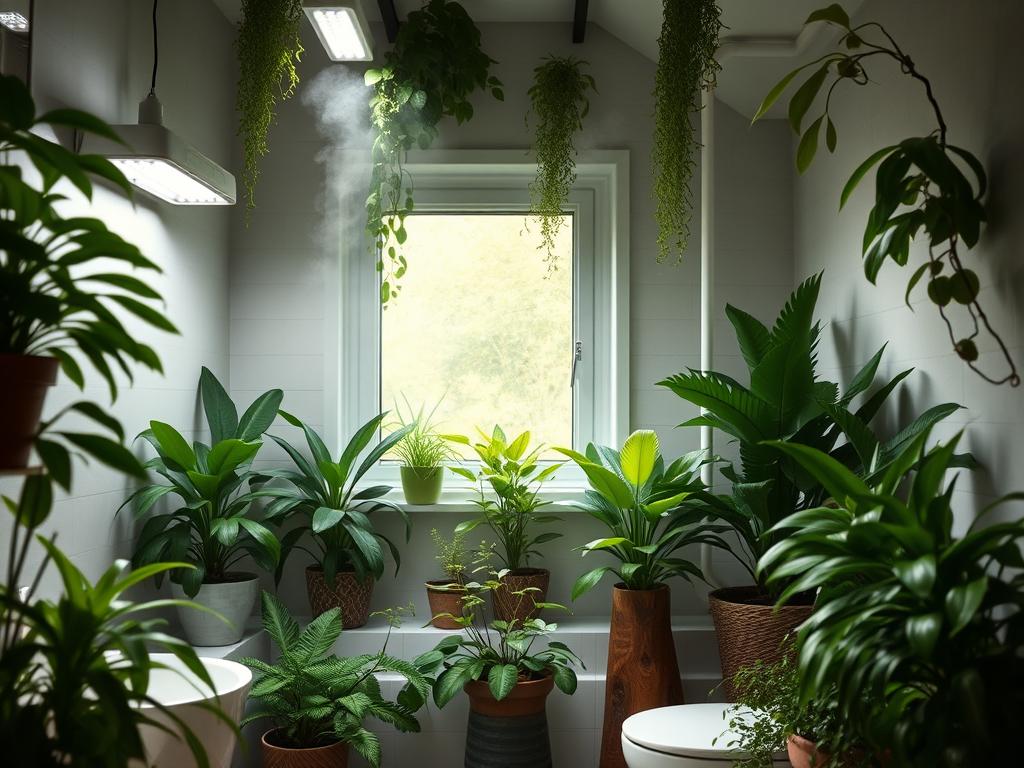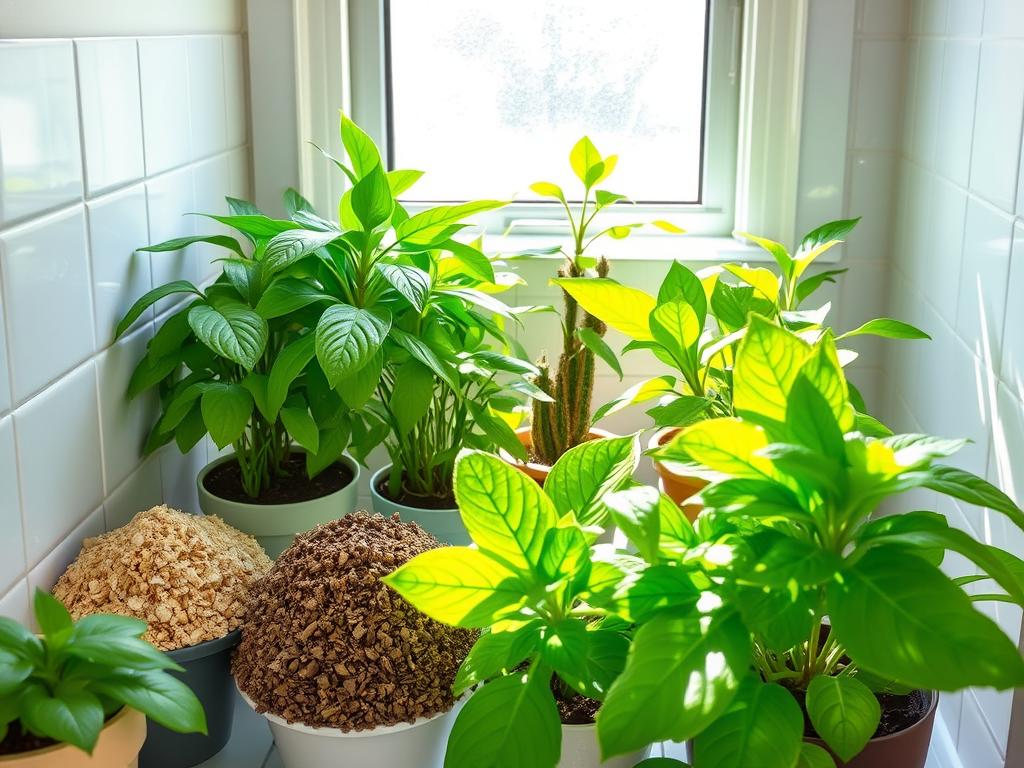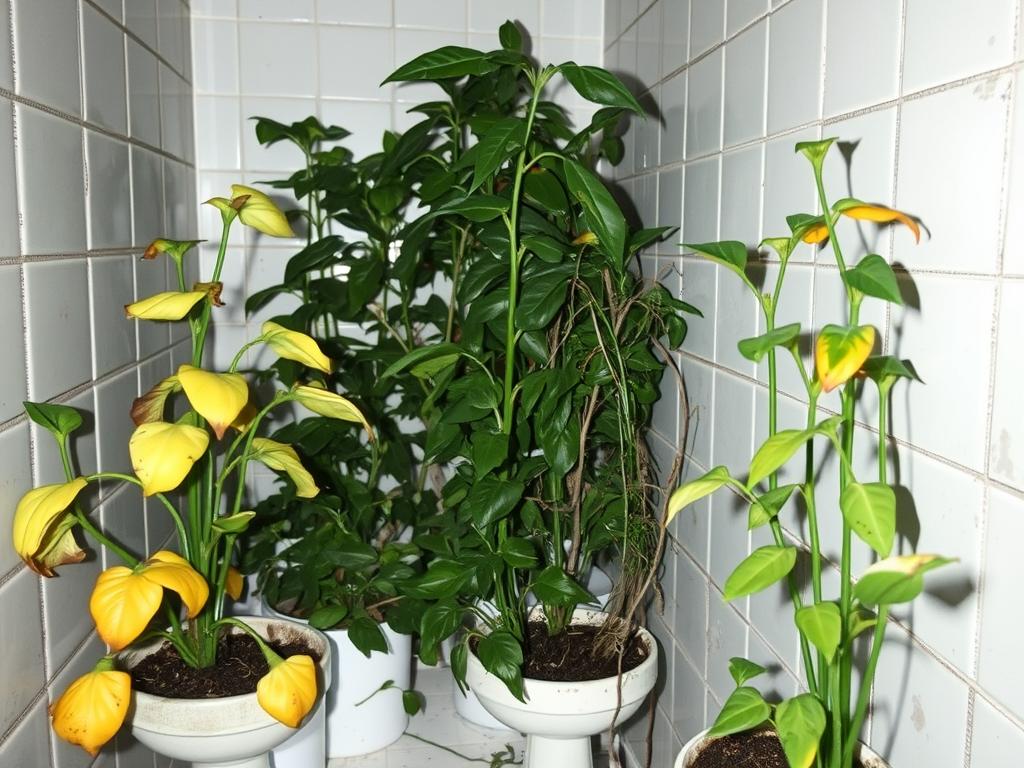Indoor gardening can change a windowless bathroom for the better. Air-purifying plants bring nature indoors and clean the air. They do well in humid, low-light spots, making them great for bathrooms without windows.
Adding plants to a bathroom can make it feel fresh and welcoming. You can choose from many plants like ferns and philodendrons that love these conditions. This guide will show you how to pick and care for the best plants for your bathroom.
Whether you’re new to plants or have experience, this article will help. We’ll cover how to pick plants, care for them, and keep them healthy without sunlight.
Key Takeaways
- Many plants can thrive in windowless bathrooms with high humidity
- Ferns, philodendrons, and calatheas are excellent choices for low-light conditions
- Air plants and lucky bamboo don’t require soil and are ideal for small spaces
- Proper watering and humidity management are crucial for plant health
- Artificial light solutions can supplement the lack of natural light
- Regular maintenance and pest control are essential for thriving bathroom plants
Understanding the Challenges of a Windowless Bathroom
Windowless bathrooms pose special challenges for plant lovers. They lack natural light, have high humidity, and are often small. But, with the right strategy, you can make these issues work for your indoor garden.
Lack of Natural Light
The main problem is the lack of sunlight. But, many plants can grow well in these conditions. Snake plants, Chinese evergreens, and pothos are great for places without direct sunlight.
High Humidity Levels
Bathrooms are naturally humid. This is good for plants like ferns and spider plants. They can make your bathroom a lush, green space. Just make sure there’s good air flow to avoid mold.
Limited Space Considerations
Bathrooms often have little room. This is where clever choices come in. Use hanging plants or vertical planters to fill your space without clutter. English ivy and Boston ferns are perfect for hanging and can decorate your walls.
With the right plants and care, you can beat these challenges. Choose plants that do well in low light, high humidity, and small spaces. This way, you can create a refreshing, green area in your windowless bathroom.
Benefits of Air-Purifying Plants in Bathrooms
Air-purifying plants are natural filters in bathrooms. They improve indoor air quality and make the atmosphere refreshing. These plants remove harmful toxins and produce oxygen. NASA research found several plants that are great at cleaning the air, perfect for bathrooms.
The Snake Plant is a top choice, available for $30 at Amazon. It gets rid of formaldehyde, found in many cleaning products. The Boston Fern, priced at $42 at Rooted, is also great for bathroom air quality.
These plants do more than clean the air. They also decorate bathrooms, making them feel like a spa. The Marble Pothos, 85% off at $49 from Easy Plant, adds elegance and purifies the air. The ZZ Plant, available for $149 at Bloomscape, is compact but still effective and stylish.
- Removes harmful toxins from the air
- Produces oxygen, improving overall air quality
- Adds natural beauty to bathroom decor
- Creates a calming, spa-like atmosphere
Adding air-purifying plants to your bathroom improves air quality and brings nature inside. The Golden Pothos, priced at $23 on Amazon, is affordable and thrives in humid environments. The Lemon Lime Prayer Plant at $25 from Rooted is a unique choice with vibrant foliage and air-purifying benefits.
Selecting the Right Plants for Your Windowless Bathroom
Choosing plants for a windowless bathroom needs careful thought. Look for low maintenance plants that do well in dim, humid places. Tropical plants are often a great choice, as they love the moist air.
Low-Light Tolerant Species
ZZ plants and snake plants are perfect for no-light bathrooms. They grow 2-3 feet tall and need little care. Peace lilies also do well in low light, cleaning the air by removing pollutants like mold spores.
Humidity-Loving Plants
Ferns love high moisture and humidity, making them great for steamy bathrooms. Boston ferns add elegance with their arching fronds. Spider plants also thrive in humid conditions and help remove toxins like formaldehyde from the air.
Space-Efficient Options
For small bathrooms, consider hanging plants or small varieties. Pothos is a great choice, with trailing vines that create a cascading effect. Chinese evergreens add a pop of color while tolerating low light. Lucky bamboo grows well in water or soil, offering versatility in tight spaces.
Remember, proper care is key. Water carefully, keep humidity up, use artificial light if needed, and fertilize sparingly. With the right plants and care, your windowless bathroom can become a lush, air-purifying oasis.
Top Air-Purifying Plants for Windowless Bathrooms
Choosing the right plants can turn your windowless bathroom into a green paradise. These plants not only love humid air but also clean it up. They’re great for keeping your bathroom fresh.
Snake plants are top picks for air purification, as NASA has shown. They grow 1 to 3 feet tall and need little care. ZZ plants, meanwhile, are drought-tolerant and do well in low light.

Peace lilies can grow up to 3 feet tall and bloom in low light. They remove toxins from the air. Chinese evergreens, known for luck, are easy to care for and fit well in small spaces.
Pothos plants can grow up to 13 feet long, making them perfect for hanging. They handle low light and high humidity well. Air plants, about 3 inches tall, need regular misting to thrive.
- Boston ferns: Can grow 3 feet tall and wide
- Spider plants: Reach 18 inches tall by 2 feet wide
- Orchids: Paphiopedilums species grow up to 2 feet tall
Don’t forget to rotate your plants every week. Using LED or T5 bulbs can also help with lighting. With these plants, your bathroom will feel clean and lively.
Care for Air-Purifying Plants in a Windowless Bathroom
Caring for plants in a windowless bathroom needs special attention. You must focus on watering, humidity, and lighting. These tips will help your plants thrive in this unique space.
Watering Techniques
Adjust your watering schedule for low-light conditions. Plants in windowless bathrooms grow slower and use less water. Check soil moisture before watering.
For ferns and pothos, keep soil consistently moist. Snake plants and ZZ plants prefer drying out between waterings.
Humidity Management
Most bathroom plants love humidity. Spider plants and Chinese evergreens thrive in moist air. Ensure good air circulation to prevent fungal growth.
For plants like rubber plants, maintain daytime temperatures around 75-80°F. Nighttime temperatures should be between 60-70°F.
Artificial Light Solutions
Grow lights for plants are essential in windowless spaces. LED or fluorescent bulbs can supplement lack of natural light. Place lights 6-12 inches above plants and run them for 12-16 hours daily.
Rotate plants weekly to ensure even light exposure. This promotes balanced growth.
Even low-light tolerant plants like lucky bamboo need some light to survive. With proper care, your air-purifying plants can flourish and enhance your bathroom’s atmosphere.
Creating the Ideal Growing Environment
Creating the right space for plants in your windowless bathroom is crucial. Arrange plants at different heights to use space well and add beauty. This setup ensures each plant gets enough light and air.
Temperature is important for your plants. Most prefer a range of 60-80°F. Snake plants and spider plants can handle a bit more, from 50-90°F. Rubber plants do best in 75-80°F during the day and a bit cooler at night.

Bathrooms are usually humid, but good air flow is key to avoid mold. Lucky bamboo and ferns enjoy the moist air. ZZ plants and Chinese evergreens are great for beginners because they’re easy to care for.
- Use full-spectrum LED lights to mimic natural sunlight
- Clean leaves regularly to improve light absorption
- Rotate plants weekly for even growth
- Consider hanging plants like English ivy or spider plants to save space
By following these tips, you’ll make a perfect spot for your plants. Remember, each plant is different, so adjust your care to meet their needs.
Proper Potting and Soil Requirements
Creating the right environment for your bathroom plants starts with proper potting. Let’s explore the essentials of containers, soil, and drainage for your green companions.
Choosing the Right Containers
Selecting the right plant containers is crucial for bathroom greenery. Opt for pots with drainage holes to prevent waterlogging in humid conditions. Terracotta pots work well for plants that prefer drier soil, as they allow excess moisture to evaporate.
Selecting Appropriate Soil Mixes
Use potting soil for bathroom plants that drains well. A mix designed for indoor plants is ideal. For humidity-loving species, add peat moss or coco coir to retain moisture. This balance ensures your plants thrive in the bathroom’s unique environment.
Drainage Considerations
Good drainage is key to plant health. Add a layer of pebbles at the bottom of your pots to improve water flow. Use saucers to catch excess water and prevent messes. These drainage solutions protect your plants from root rot in high-humidity bathrooms.
Remember, the right combination of containers, soil, and drainage sets the stage for healthy, happy plants in your windowless bathroom. With these basics in place, your air-purifying plants will flourish, creating a fresh and inviting space.
Fertilizing Air-Purifying Bathroom Plants
Proper plant nutrition is key for air-purifying plants in windowless bathrooms. These plants grow slower in low-light conditions, so they need less fertilizer. A balanced approach to feeding is crucial for their health and air-cleaning abilities.
For best results, use water-soluble fertilizers at half strength. Apply them every 4-6 weeks during spring and summer, when plants are actively growing. This feeding schedule prevents nutrient buildup in the soil, which can harm your plants.

Organic fertilizers are ideal for bathroom plants. They release nutrients slowly, reducing the risk of over-fertilization. Plus, they’re safer in small spaces like bathrooms. Some great options include:
- Compost tea
- Worm castings
- Fish emulsion
Remember, less is more when it comes to fertilizing bathroom plants. Over-fertilizing can lead to salt buildup in the soil, damaging roots and leaves. If you notice yellowing leaves or stunted growth, cut back on your feeding schedule.
By following these guidelines, you’ll keep your air-purifying plants healthy and thriving in your windowless bathroom. With proper care, plants like Parlor Palm and Aglaonema will continue to clean your air and add a touch of nature to your space.
Pruning and Maintenance Tips
Keeping your bathroom plants healthy is key. Regular grooming and care are essential. Remove yellow or dead leaves to stop disease and keep things neat.
For plants like pothos, trim them now and then. This helps them grow fuller and prevents them from getting too long in dim light.
In small bathrooms, managing plant growth is important. Cut back overgrown plants to keep them in shape. Wipe leaves with a damp cloth to get rid of dust and help them absorb more light.
This simple action can greatly improve your plants’ health and look.
Here are some quick tips for effective plant maintenance:
- Prune regularly to promote healthy growth
- Remove dead or yellowing leaves promptly
- Trim trailing plants to prevent tangling
- Clean leaves to enhance light absorption
- Maintain proper shape and size for your space
Remember, different plants have different needs. Snake plants, for example, can grow up to 2 to 4 feet tall and need little pruning. Pothos plants, however, need trimming to avoid tangling.
By following these grooming tips, your bathroom plants will flourish. They’ll keep the air clean and fresh.
Dealing with Common Plant Issues in Windowless Bathrooms
Growing plants in windowless bathrooms is tricky. The lack of natural light and high humidity can cause problems. We’ll look at ways to control pests and prevent fungus to help your plants thrive.
Pest Prevention and Control
Pests can be a problem in any indoor garden. In windowless bathrooms, pests are attracted by the humid air. Regular checks help catch pests early.
If you find pests, separate the affected plant right away. Natural solutions like neem oil can fight pests without harming your plants.
Addressing Fungal Growth
Bathrooms are humid, which can lead to fungus. To stop this, use a small fan to improve air flow. Don’t water your plants too much, as this encourages fungus.
If fungus appears, a weak hydrogen peroxide solution can help. It’s a safe way to fight fungus without using harsh chemicals.
Troubleshooting Yellowing Leaves
Yellow leaves mean your plants are getting too much water or not enough light. In windowless bathrooms, finding the right balance is key. Grow lights can help make up for the lack of natural light.
The Eco Hanging Spider Plant, priced at £29 from Bloom & Wild, is a good choice for low light. It helps you figure out the best conditions for your plants.

If your plants still have issues, it might be time to change their spot. Move them to a brighter area sometimes. With the right care, you can overcome common problems and have a healthy green space in your windowless bathroom.
Rotating Plants for Optimal Health
Plant rotation is crucial for keeping your bathroom plants healthy. It helps them grow evenly and get the right amount of light. By moving plants to brighter spots, you meet their light needs and avoid uneven growth.
For plants in very dim light, try a weekly move to a sunnier spot. This keeps them strong and effective at cleaning the air. Different plants need different amounts of light:
- Lucky Bamboo does well in moderate or indirect sunlight
- Spider Plants like bright, indirect light
- Snake Plants can handle shady spots or windowless bathrooms
Make sure to match each plant’s light needs for the best growth. For example, Pothos does okay in low light but grows faster in bright spots. Rotate these plants often to give them enough light.
With a smart plant rotation plan, your bathroom plants will thrive. This way, they can do their best to purify the air.
Incorporating Plants into Your Bathroom Decor
Turn your windowless bathroom into a green paradise with smart plant displays. Let nature’s power boost your bathroom’s look and feel. Hanging planters save space and add beauty, improving air quality too. Try hanging Boston Ferns or Spider Plants for a lush look.
Make a bold statement with a vertical garden on your wall. It’s a smart way to use space and bring in green vibes. Mix plants like delicate Maidenhair Ferns with bold Snake Plants for depth and interest.
Choose pots that match your bathroom’s colors for a cohesive look. Modern pots fit sleek designs, while terracotta adds a rustic touch. The right plants and pots can make your bathroom a relaxing spa, improving its look and your mood.
FAQ
What are the benefits of having air-purifying plants in a windowless bathroom?
Air-purifying plants make the air cleaner by removing toxins and adding oxygen. They also make the bathroom look nicer and feel like a spa. This brings a bit of nature into your bathroom.
Which plants are suitable for a windowless bathroom?
Good choices for windowless bathrooms include ferns, philodendrons, and calatheas. Pothos, snake plants, and ZZ plants also work well. Peace lilies, Chinese evergreens, and others that like low light and high humidity are great too.
How do I care for plants in a windowless bathroom?
For plants in a windowless bathroom, water them less than you would in brighter spots. Use shower steam to keep the air moist. You can also add LED grow lights or fluorescent bulbs to help with the lack of natural light.
What are the ideal potting and soil requirements for bathroom plants?
Choose pots with holes to drain excess water and use indoor plant potting mixes. For plants that love humidity, add peat moss or coco coir. Use terracotta pots for plants that prefer drier conditions.
How often should I fertilize air-purifying bathroom plants?
Fertilize your bathroom plants rarely. Use a balanced, water-soluble fertilizer at half strength every 4-6 weeks in spring and summer. Choose organic fertilizers to avoid harmful chemicals.
What maintenance is required for bathroom plants?
Keep your bathroom plants healthy by pruning them regularly. Remove yellow or dead leaves and trim any overgrown parts. Clean their leaves with a damp cloth to remove dust and help them absorb more light.
How do I deal with common plant issues in a windowless bathroom?
To prevent pests, check your plants often. Control fungal growth by improving air flow and not overwatering. If leaves turn yellow, adjust how often you water or the light they get. Use neem oil for pests and hydrogen peroxide for fungus.
Should I rotate my bathroom plants?
Yes, rotating your plants helps them grow evenly and get enough light. Move them to brighter spots for a few days each week. This prevents them from growing unevenly.
How can I incorporate plants into my bathroom decor?
Use hanging planters, shelves, or window sills to display your plants. You can also create a vertical garden with wall-mounted planters. Mix different plant sizes and textures. Choose decorative pots that match your bathroom’s style and color.
